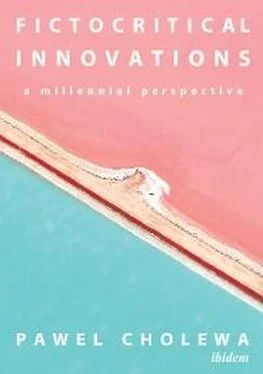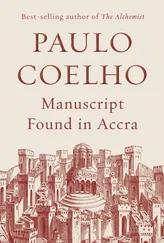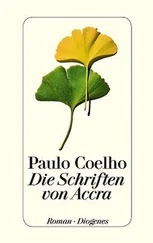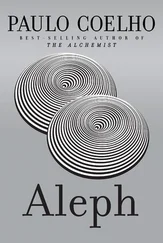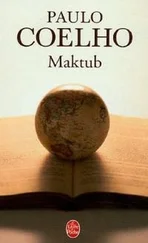All of these folios incorporate different experimental writing techniques, including first-person narrative, prose-poetry, flash fiction, travel writing, vignettes, stream of consciousness, memoir, autobiography, fiction, creative non-fiction, autoethnography, song lyrics, mantras/meditations, narcissistic critique, storytelling, double-voicedness and soliloquy. The folios also use different voices, personas or narrators depending on what the folio and thesis are trying to portray and uncover. Yet all of these approaches can tentatively fall under the methodological umbrella of fictocriticism as the genre has quite a broad (possibly limitless) scope, particularly for experimentation. Still, the folios arguably becomes progressively more fictocritical as the theses develop and sustain their arguments about fictocritical innovations and discoveries, and as the creative self uncovers subtextual layers and improves upon the necessary critique in the folios. In this ‘confused’ way the folios are not entirely elegant or aesthetically pleasing. They incorporate their own mistakes and inconsistencies throughout the narrative, just as Mark Z. Danielewski preserves his mistakes and crossings out throughout House of Leaves (114-15).
In these creative works, however, I at least attempt to (consistently) employ the fictocritical solution to the ‘failure’ of the formal omniscient and/or masterful position, the view from nowhere, because now it is more accepted that knowledge is situational and contextual. Again, this partly stems from the feminist influence of fictocriticism, with its emphasis on the personal being political. Other solutions (and innovations) will be examined within the context of this exploration’s theses, as I/we progress through them.
Regarding viewpoints, because of the massive variations in my creative pieces’ lengths and styles/forms (there are many), not every narrator or scene in every one of the creative works is permitted a concrete (physical) description. This is done to save space and time. After all, for the record, basically all of the narrators/personas are more or less ‘reflections’ (‘ghosts’) of the same being/author (me) anyway. Also, as indicated by Haas, one of the common fictocritical markers is “minimal characterisation and dialogue” (26), which I tend to agree with (overall). That is not to say that my creative works do not feature dialogue and character description at all. These traits feature very prominently in the folios on family and education in particular, but dialogue and character description are not the focus here, as there are many other bases to cover, and more importantly to ‘play’ with, in order to uncover the breadth of fictocriticism’s potential, and what possible innovations lay dormant within it.
Taking this broad approach further, occasionally some of the creative pieces are left ‘seemingly’ unfinished, to indicate where the creative self could (or does not) elaborate on a concept because it would make it less or more fictocritical. This makes aspects of the folio work open-ended. An argument against this approach could be that it demonstrates a lack of texture, and intellectual resources, in the writing. Though it is this book’s contention that the creative folios certainly did not need to be completely polished pieces of work. In fact, aesthetic and commercial sleekness was deliberately resisted so that the work would be more experimental. This became the plan and methodology following this study’s first draft. This restructuring or deconstructive process became part of this book’s reviewed and renewed goals. This would ensure that this ‘experiment’ in fictocriticism was more official. And in reviewing the creative self’s work the analytical self is then able to better take on the responsibilities of a literary scientist in the more theoretical theses.
The open-ended nature of the ‘experimental’ creative folios make it so the works cannot be considered pure memoir or autobiography as they are, in essence, abstract(ed) and fictionalised accounts. Though they contain obvious elements of these forms, particularly Folios One and Two, where pseudonyms and leeway are given to the expression and dramatisation of real people, places and events, the creative work(s) do not subscribe to any one genre exclusively. The creative works must be considered a fictocritical ‘experiment’ because of the blending of so many differing genres and forms. Most importantly, the folios must be fictocritical because, as a whole, they are essentially half-creative, half-critical.
Finally, by 2018-19 my literature review found that there are only a small number of theses devoted to a personally exploratory and/or specifically fictocritical, critical or ‘fictocritical-esque’ hybridised methodology. These include Monique Louise Trottier’s Masters thesis “If Truth be Told…” (2002), The Holocaust at Home: Representations and Implication of Second Generation Experience (2004), a North American doctoral dissertation by Susan Jacobowitz about the literary experiences, identities and representations of second generation Holocaust survivors (iv); Brent Jason Royster’s “The Construction of Self in the Contemporary Creative Writing Workshop: A Personal Journey” (2006), Jeanette Weeda-Zuidersma’s “Keeping Mum: Representations of Motherhood in Contemporary Australian Literature—a Fictocritical Exploration” (2007), “Between the City and the Bush: Suburbia in the Contemporary Australian Novel” (2008), a North American literary doctoral dissertation by Nathaniel David O’Reilly, Emily Naismith’s Honours thesis “Emily Coughs: A Fictocritical Exploration of the Self via Social Media” (2009), Danuta Raine’s “Essaying the Self: Ethnicity, Identity and the Fictocritical Essay” (2009), Jorge Villalobos’ “My Name Is/Mi Nombre es: Developing Internal Voices in a Quest of an Identity” (2012), Robin Hely’s “Project Neurocam: An Investigation” (2013), Lissi Athanasiou Krikelis’ “Postmodern Metafiction Revisited” (2014) and Ania Walwicz’s 2016 PhD “horse: a psychodramatic enactment of a fairytale”. As can be seen from these titles, they are similar to this work in that they are literary, often fictocritical, autobiographical, a form of storytelling and they explore personal(ised) themes, yet these themes or autobiographies are not simultaneously Polish-Australian, male or about the primary themes addressed in this study: journeys, family, education and technology.
The works listed above relate to specific aspects of these individual writers’ lives, ideas, beliefs, identities, philosophies and experiences that make them them (i.e., motherhood, love, religion, ancestry, social media and cystic fibrosis, a Mexican-American upbringing, and so forth). These documents are unique to these individual people, though none are like this exploration because none of them are me. None of them feature a crossover or dense tapestry of interests or experiences that specifically include a fusion of travel, education, a hybridised Polish-Australian background and living in the digital world. And that unique fusion, in the combination and sequence of four experimental folios, is one of the ways that make this experimental fictocritical exploration unique, amongst a set of existing ‘fictocritical-esque’, personalised and explorative works that are already marginal, fairly radical or unorthodox in their format and structure, and certainly relatively few in number.
From this point onwards, my cognitive self will be split in two: when referring to my ‘self’ or the multiplicity of my various ‘selves’ that feature in the creative folios, ‘I’ shall be referred to as the creative self; I will then shift to an alternate clinical persona known as the analytical self in the four theoretical theses, critiquing the creative self’s writings for their merit and fictocritical innovativeness. And when referring to my other, full, self, i.e., both my creative self and my analytical self together (i.e., the complete ‘Pawel Cholewa’), in moments where both intersect and are relevant/applicable, I will simply refer to my collective person as the author. This (somewhat) goes without saying, but not to worry! Context shall make this clear enough, to be sure.
Читать дальше
